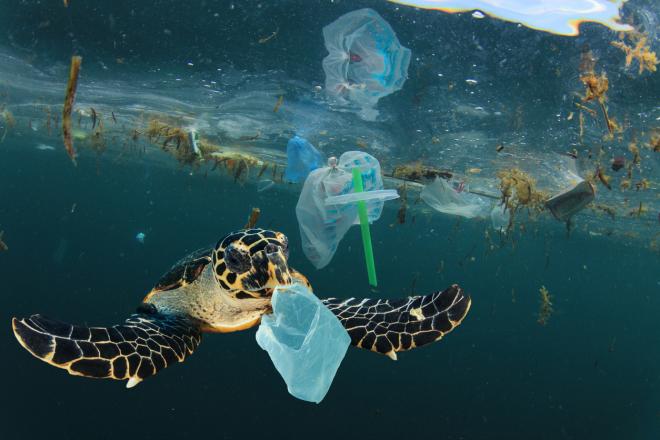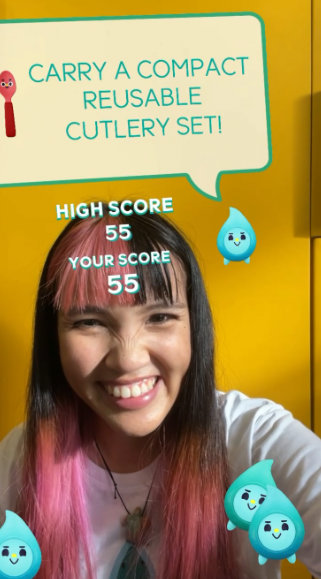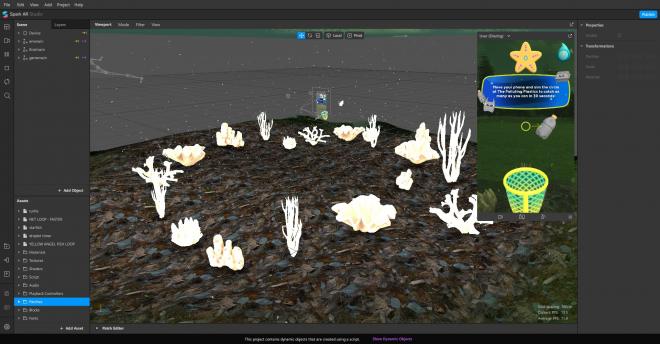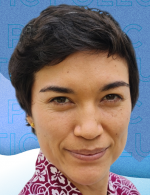
This article is published in collaboration with The MeshMinds Foundation.
“Individually, we are one drop, together we are an ocean.”—Ryunosuke Satoro
Plastic waste is choking seas and coasts and threatening ecosystems, livelihood, and lives in Southeast Asia. Due to the coronavirus disease (COVID-19) pandemic, the world is now fighting a plastic pandemic of new waste created from “new norms” of plastic consumption, such as the use of single-use plastics, including personal protective equipment.
Southeast Asia is at the heart of this marine plastic pollution challenge. Six of the top 20 polluters of marine litter are in Southeast Asia, making the region a major hotspot for plastic pollution. With single-use packaging, masks, and gloves piling up on beaches, and informal sector waste workers increasingly endangered, the direct impact that marine litter has on the livelihoods of disadvantaged local communities as well as the environment is clear.

“Plastic waste is a major threat to the people, environment, and economies of Southeast Asia. We want to beat plastic pollution by changing how we produce, consume, dispose of, and recover plastic products. We are glad to work with partners to deploy cutting-edge technologies to mobilize, educate, and build a strong community of sustainability advocates,” said Kamala Ernest, SEA circular project coordinator at the United Nations Environment Programme (UNEP).
100 Days to #BeatPlasticPollution is a campaign developed by the SEA circular project and The MeshMinds Foundation to create region-wide awareness on plastic pollution and public support for policies to change plastic value chain management. The SEA circular project is an initiative of UNEP and the Coordinating Body on the Seas of East Asia (COBSEA).
Beating plastic pollution
The 100 Days to #BeatPlasticPollution campaign targets young people, 13 to 25 years old, across Southeast Asia—Cambodia, Indonesia, Malaysia, the Philippines, Singapore, Thailand, and Viet Nam. The campaign aims to mobilize digitally connected youth to adopt habits that will help turn the tide on the plastic pandemic.
At the heart of the campaign is an augmented reality (AR) -powered interactive showcase on Instagram, enjoining sustainability advocates to join the #BeatPlasticPollution movement.
In a recent study by SEA circular, social media was perceived by 88% of consumers as the most effective platform to learn more about and be encouraged to take action on plastic waste issues. Research shows that, on average, it takes 66 days for a new behavior to become automatic.
Through the campaign, people are challenged to choose one simple habit that can be sustained for 100 days, and kept for life. The mission is to educate and build a strong community of sustainability advocates who want to beat plastic pollution. The vision is for “less plastic wasted” to stop the flow of plastic into the ocean, which is projected to nearly triple by 2040.
Advocates are invited to join the campaign via Instagram using a digital toolkit with AR-enabled games and filters: “Say No To Single-Use”, “Clean Our Oceans”, “Drowning In Plastic”, and “Meet the Reusables”.
Say No To Single-Use is an AR game that features the player’s face. With the camera facing front, images of single-use plastics or reusable alternatives dance across the screen. Each time an image appears on the screen, the user needs to nod or shake his head to express approval. A nod for every reusable alternative gets him points.
Clean Our Oceans is another AR game, but this time using the world around the player to create the feeling of being underwater. With the camera facing front, images of single-use plastics swim across the screen. The user needs to catch the floating plastics by moving their phones around.
Drowning In Plastic is an AR filter used to edit photos of faces taken with the app The filter allow the user to star in their online pledge. Once the app detects a face on the screen, a shower of plastic garbage fills the screen and forms a "garbage mask”, with the actual eyes and mouth of the user. With the shake of the head, the garbage falls off, giving way to images of reusable alternatives around the image of the user.
Meet the Reusables is an AR filter that allows the user to superimpose virtual objects onto photos of the real world. Using the back-facing camera, the user is given the option to place an image of the campaign’s reusable alternatives on images they can share with friends. People can tap the screen to place and pinch the screen to change the size of each item.
All the games and filters are available on UNEP’s Instagram account.

Digital toolkit
In building the digital toolkit, The MeshMinds Foundation was supported by the Spark AR Partner Network, an invite-only network set up by Facebook for the world’s leading developers who use its AR creation software.
Through a combination of sponsorship and in-kind support, AR production companies, MeshMinds (the foundation's sister company), Shadow Factory, and GOWAAA, worked together to create the AR experiences. The MeshMinds Foundation chose the three teams on the basis of their portfolios of Spark AR experiences. From there, they were given access to the 2D and 3D characters designed by Tokyo-based illustrator Cesc Grané. The teams used 3D computer graphics program Autodesk 3ds Max, design program Adobe Illustrator, image editing application Photoshop, and digital illustration app Procreate.
Grané used colors, shapes and facial expressions to differentiate and emphasize the concept behind the images of the “Polluting Plastics” and the “Reusables” used in the campaign. The Reusables are made with round shapes, primary colors and kind face expressions to make them look soft and friendly. On the other hand, the Polluting Plastics are mainly gray with a small amount of yellow to alert attention, similar to the amber light on traffic signals. “With the combination of these colors, together with dented shapes on the bodies and angry facial expressions, I created a bunch of villain characters that we definitely want to defeat,” said Grané.
Roger De Leon, brand director, Shadow Factory, said: “It was important for us to take on the 100 days of change head-on. We wanted to show that something as simple as switching to a reusable alternative from a single-use plastic could be extremely effective if continuously used over time. So our focus became the ease of choosing reusable over single-use plastic.”
Tan Yu Yan, GOWAAA cofounder, said in making the AR images and effects, they considered that not everyone in Southeast Asia has a choice to avoid single-use plastic due to poverty and poor sanitation. So they decided to focus on raising awareness that single-use plastic is finding its way into oceans. This helped the team define the objective of Clean Our Oceans, which is to race against a 30-second timer to collect as many plastics thrown into the ocean as then can, he said. “During the game play, people see two extremes of the oceans: An unhealthy polluted ocean filled with single-use plastic versus a clean ocean teeming with corals and marine life.”
Olivier Bos, chief inspiration officer, MeshMinds, said the concept about Drowning In Plastic was inspired by the circular economy. “We wanted to create a sense of being engulfed in a deluge of single-use plastic and mix that with the recent trend of filters that only show a person’s eyes and mouth popping out. Drowning In Plastic invites people to shake their heads to free themselves of the Polluting Plastics before they are rewarded with the Reusables that appear on a pathway around their head.”
For Meet the Reusables, he said, the campaign team wanted to allow people to gather their friends and be as creative as possible. “Our dream is to see a giant reusable bottle on top of bags of single-use plastics gathered from a beach clean-up. Or, a group of friends lining up behind a giant reusable mask. There are so many possibilities with each of the Reusables and we can’t wait to see what people come up with.”
Frontier technologies
There is a growing trend for organizations to turn to frontier technologies, such as AR and virtual reality, to raise awareness and engagement on the effects of climate change and ultimately inspire positive behavioral change. In 2020, National Geographic launched its first AR filter on Instagram enabling users to see the world as a 3D model with projected climate data from 2070 in 12 key cities. This year, luxury fashion and beauty platform, NET-A-PORTER used nine AR face effects to re-launch NET SUSTAIN, its curated platform of fashion and beauty products that have been consciously crafted.
In June, Facebook shared in its Hello Future, AR/VR Report that globally, 78% of people say AR is a fun way to interact with brands and 74% believe AR can even bridge the gap between online and offline.
AR can allow people to visualize and understand the world. What will the world look like 10, 20, or 30 years from now if things do not change? That can be demonstrated using AR.
For World Environment Day 2021, UNEP launched its Ecosphere AR campaign, in partnership with UN Goodwill Ambassadors Dia Mirza, Alex Rendell, and Antoinette Taus to show the effects of human-caused degradation in the mountains of India, the mangroves of Thailand, and the coral reefs of the Philippines. By employing the golden rule of “show, don’t tell” and visual literacy techniques to power its environmental storytelling, UNEP was able to significantly increase the number of people based in Asia to join #GenerationRestoration.
Half the battle for protecting the planet is won by helping people understand how what they do affects the environment. Thereafter, mobilizing each individual to take simple everyday actions is key to harnessing the power of collective behavioral change.
Join the movement for 100 Days to BeatPlasticPollution. Choose one simple habit that can be sustained for 100 days, and kept for life.
Act now. Together, we can #BeatPlasticPollution.
|
How to join the movement Share your new habit or your positive action for the planet with your network on Instagram: 🔎Go to @unep and find the Effects tab ✨ 🤳Choose from “Say No To Single-Use”, “Clean Our Oceans”, “Drowning In Plastic” or “Meet The Reusables.” Take a photo or video and share. 🔔Share and tag three friends to join the movement to #BeatPlasticPollution. 🍀Bonus: Tag @unep and @meshminds for a chance to get featured. 🔥Hot Tip: Search “beatplasticpollution” for stickers to add to your pledge. To power up your WhatsApp messages with the 100 Days to #BeatPlasticPollution message, download the free animated sticker pack here: http://l.ead.me/bpp-stickers. To create your own 100 Days to #BeatPlasticPollution tile, using Canva, check out: http://l.ead.me/bpp-canva. |
|
|
Kay Vassey is the founder of The MeshMinds Foundation. |



